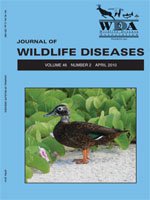Laysan Ducks are endemic to the Hawaiian archipelago and are one of the world's most endangered waterfowl. For 150 yr, Laysan Ducks were restricted to an estimated 4 km2 of land on Laysan Island in the northwestern Hawaiian Islands. In 2004 and 2005, 42 Laysan Ducks were translocated to Midway Atoll, and the population increased to approximately 200 by 2007. In August 2008, mortality due to botulism type C was identified, and 181 adult, fledgling, and duckling carcasses were collected from August to October. Diseased birds were found on two islands within Midway Atoll at multiple wetlands; however, one wetland contributed most carcasses. The epidemic was discovered approximately 14–21 days after the mortality started and lasted for 50 additional days. The details of this epidemic highlight the disease risk to birds restricted to small island populations and the challenges associated with managing newly translocated endangered species. Frequent population monitoring for early disease detection and comprehensive wetland monitoring and management will be needed to manage avian botulism in endangered Laysan Ducks. Vaccination may also be beneficial to reduce mortality in this small, geographically closed population.
How to translate text using browser tools
1 April 2010
AVIAN BOTULISM: A CASE STUDY IN TRANSLOCATED ENDANGERED LAYSAN DUCKS (ANAS LAYSANENSIS) ON MIDWAY ATOLL
Thierry M. Work,
John L. Klavitter,
Michelle H. Reynolds,
David Blehert
ACCESS THE FULL ARTICLE

Journal of Wildlife Diseases
Vol. 46 • No. 2
April 2010
Vol. 46 • No. 2
April 2010
Anas laysanensis
botulism
Clostridium botulinum
endemic island waterfowl
Laysan teal
waterfowl disease




